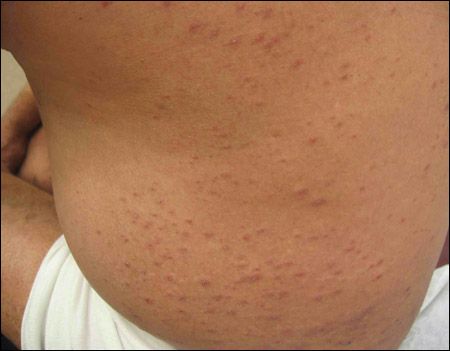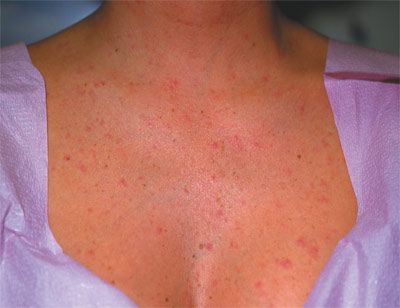- Clinical Technology
- Adult Immunization
- Hepatology
- Pediatric Immunization
- Screening
- Psychiatry
- Allergy
- Women's Health
- Cardiology
- Pediatrics
- Dermatology
- Endocrinology
- Pain Management
- Gastroenterology
- Infectious Disease
- Obesity Medicine
- Rheumatology
- Nephrology
- Neurology
- Pulmonology
Folliculitis: Part II
Here a close-up look at fungal, eosinophilic pustular, and steroid-induced folliculitis.
Fungal folliculitis. This infection, which preferentially affects young women, appears as asymptomatic, slightly pruritic, follicular papules and pustules on upper back and chest, upper arms, and neck. The eruption may be acneiform and monomorphous. Treatment choices include antifungal body washes, sulfur-based antibiotic washes, oral antifungal antibiotics, and topical antifungal cream.
Eosinophilic pustular folliculitis. This type of folliculitis appears as erythematous, painful, intensely pruritic papulopustules. Patients have repeated episodes on the face, back, and upper extremities that usually last 7 to 10 days and recur every 3 to 4 weeks. Eosinophilic pustular folliculitis is classically considered idiopathic. However, variants have occurred in patients with systemic diseases, such as AIDS and chronic lymphocytic leukemia. The condition is about 5 times more common in men than in women. Medications associated with this type of folliculitis include minocycline, carbamazepine, allopurinol, indeloxazine hydrochloride, and possibly cyclophosphamide. Treatment generally consists of topical therapies, including corticosteroids, UVB phototherapy, psoralen-UVA, and indomethacin.
Steroid-induced folliculitis. This type of folliculitis is asymptomatic and appears as acneiform, usually monomorphous lesions. Outbreaks, which are abrupt, are attributable to high doses of corticosteroids. Discontinuation of the corticosteroids results in a slow resolution of the eruption.
On the following pages, you will find images of all 3 types.
Fungal. A 25-year-old woman has been bothered by a persistent, slightly pruritic acneiform eruption on the upper trunk and proximal arms. Oral and topical antibiotics have not helped. Pityrosporum folliculitis was the diagnosis.

Fungal. A 34-year-old man has had an acneiform eruption in his mustache. He has seasonal allergies, for which he uses a corticosteroid nasal spray and an oral nonsedating antihistamine. A culture confirmed the diagnosis of candidal folliculitis, most likely caused by the corticosteroid nasal spray, which created an environment hospitable to the infection.

Eosinophilic pustular. This 48-year-old, HIV-positive man presented with new-onset acne-like, pruritic lesions on his face. These erythematous painful papules had developed 2 months before presentation. A biopsy specimen showed abundant eosinophils and superficial granulomatous infiltrate.

Eosinophilic pustular. These pruritic pustules appeared on the lower back of a 45-year-old man and progressively spread to the entire back over a month. He had recently completed chemotherapy for chronic lymphocytic leukemia.

Steroid-induced. This asymptomatic acneiform outbreak erupted on the upper chest of a 24-year-old woman after she was hospitalized for an asthma exacerbation.

